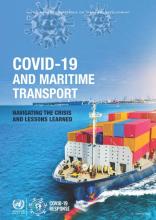
BUILDING CAPACITY TO MANAGE RISKS AND ENHANCE RESILIENCE A Guidebook for Ports
The guidebook presents a step-by-step approach to resilience building in the maritime supply chain. It sets out risk identification, assessment and management tools and techniques, and describes a resilience-building process for ports.
The guidebook emphasizes lessons learned and good practices and highlights relevant measures that can be implemented to prepare, respond and recover from disruptions.

Resilient Maritime Logistics Website
The Resilient Maritime Logistics website (https://resilientmaritimelogistics.unctad.org) hosts a guidebook for ports aiming at Building Capacity to Manage Risks and Enhance Resilience. It features risk identification, assessment, and management tools and approaches, case studies, good practices and a step-by-step resilience-building process for ports and other relevant maritime supply chain actors. The guidance focuses on three types of resilience-building actions and measures, namely:
- Before a disruption materializes.
- During a disruption.
- After a disruption.
A course structured around six modules and focusing on Port and Maritime Supply Chain Resilience accompanies the guidance on this website. The training will help to better understand the importance of well-functioning maritime supply chains and ports for highly interdependent world economies and the need to build their resilience in the face of heightened, uncertainty and disruptions.
The Resilient Maritime Logistics website and related content and material aim to help stakeholders across the maritime supply chain to better manage risks, prepare in the face of disruptions, ensure effective response measures and enable rapid recovery. Targeted stakeholders include (i) governmental planning and regulatory agencies; (ii) port authorities; (iii) port operators and port management companies; (iv) terminal operators; (v) infrastructure managers; (vi) freight forwarders; (vii) customs authorities; (viii) carriers and shipping companies; (ix) shippers and cargo owners; and (x) inland carriers and inland logistics operators (e.g. dry ports, inland container depots, warehouses, logistics and distribution centres). Collaboration between each of these stakeholders is critical for maritime supply chain agility and resilience-building.

COVID-19 and Maritime Trasport: Navigating the Crisis and Lessons Learned
UNCTAD's report "Covid-19 and maritime transport: Navigating the crisis and lessons learned" describes how the COVID-19 pandemic shocked the global maritime transport system and some of the key effects on the sector. It highlights challenges arising from the disruption across ports and hinterland connections and examines response and mitigation measures implemented by various stakeholders. It sets out the key lessons that can inform and guide preparedness and resilience-building efforts in transport and logistics.
The Model Subregional Agreement on Transport Facilitation
The Model Subregional Agreement on Transport Facilitation has been elaborated on the basis of findings of comparative studies between major subregional agreements on transport facilitation to which various ESCAP member States are parties, conducted in 2014-2015. It has been subsequently reviewed by two regional expert meetings held in 2015 and finalized with incorporation of ESCAP member States’ comments.
Training Manual on Operational Aspects of Multimodal Transport
Acknowledging the importance of multimodality in enhancing the seamlessness of supply chain and logistics network for ESCAP member countries, including landlocked developing countries (LLDCs), the “Training Manual on Operational Aspects of Multimodal Transport” was developed as part of ESCAP Transport Division initiatives to improve technical knowledge of the transport and logistics sector and to support human resource development and capacity-building of ESCAP member countries.